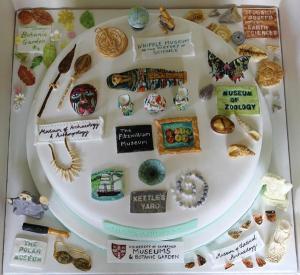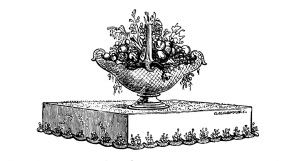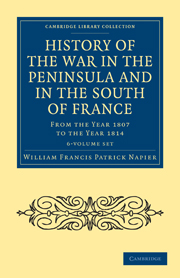Some expert recipes…
I reported on Tuesday on CLC’s birthday, and its cake, but we were trumped the following day by a superb example celebrating the first anniversary of our Author Hub website, and yesterday, the Cambridge University Museums Twitter feed was showing off its magnificent centrepiece for its ‘annual summer gathering’, made by Sarah Allbrook. (I assume my invite has gone astray in the post…)
So I thought I would banish jealous thoughts by offering some cake recipes from our cookery authors, who between them have quite a lot to say on the subject. Let’s begin with Louis Eustache Ude, ‘ci-devant cook to Louis XVI’ who published The French Cook in 1813. (It went into many editions of which ours is the eighth of, 1827.) He is not strong on cakes, though massive on various pastries, biscuits, cheesecakes, jellies, creams, and preserved fruits, the ‘entremets’ of the elaborate dinners ‘à la française’, which had piles of dishes, sweet and savoury, at each of several courses.
Here are his instructions for ‘baba’. First make your brioche paste, the recipe for which begins: ‘Take fifteen good fresh eggs, four pounds of very dry flour, and two pounds of fresh butter…’. (At the point of adding the eggs to the yeast dough, he advises: ‘smell them successively to ascertain if they are good’.) Anyway, have ready some brioche paste. ‘Take eight grains of saffron, which infuse into a little water, and then pour this water into the paste; add two glasses of Madeira, some currants, raisin, and a little sugar … You must butter the mould when you put them in; the oven must be moderately hot, as the babas must remain a long time in; after one hour you must look at them, and preserve the colour by putting some paper over them.’ A bit lacking in precise detail, perhaps – Ude was writing for fellow professionals – but almost certainly toothsome.
Alexis Soyer was not short of fanciful ideas alongside the completely practical ones exhibited in his travelling stove and his soup kitchens in famine-wracked Ireland. Here is a recipe from The Modern Housewife or Ménagère, devised, allegedly, after a dream in which the (female) narrator provided a huge cake for children, including the royal family and therefore called ‘St James’s Cake’.
‘Put one pound of very fresh butter in a good-sized kitchen basin, and with the right hand [what, no wooden spoon?] work it up well till it forms quite a white cream; then add one pound powdered sugar, mix well, add ten eggs by degrees; put to dry a pound and a quarter of flour, [see Ude above – was flour usually damp?] which mix as lightly as possible with it; blanch and cut in slices two ounces of pistachios, two ditto of green preserved angelica, add two liqueur glasses of Noyau, two drops of essence of vanilla; whip a gill and a half of cream till very thick, mix lightly with a wooden spoon, have a mould made the shape of the drawing, put it in and send to the baker [presumably it would be too big for a domestic oven]; it will take about one hour and a quarter to bake; ornament as represented in the subjoined cut’:
This recipe demonstrates the peril of not reading it through before you start: imagine getting as far as ‘have a mould made the shape of the drawing’, your hands dripping with mixed sponge…
Mrs Rundell, scourge of the inattentive housekeeper and the wasteful servant, lightens up occasionally. Here is her recipe for almond rout cakes: ‘Work a pound of almond paste into a pound of wheaten and an ounce of rice flour, with white of eggs, to a stiff paste; separate it into different portions, and colour one with the spirit of cochineal, another with saffron, spinach, etc., and add grated citron, lemon zest, or pralineed orange flowers, thin chips of angelica, confected pine-apples, or ginger; make them in different shapes. Different colours may be squirted over the cake, or decorate them with any nice confection.’ Janeites will remember that Mrs Elton was a little shocked at ‘at the poor attempt at rout-cakes’ in provincial Highbury: try this at home – you presumably bake them until crisp?
From the recipe book of Mistress Margaret Dods of the Cleikum Inn (alias the shrewd Scots journalist Christian Isobel Johnstone: is this the first example of a fictional character publishing a cookbook?), I’ve chosen ‘Scotch Diet-Cake’: ‘Take a pound of fine sugar sifted, the same weight of eggs very well whisked, and mix and beat them together for twenty minutes. Season with lemon-grate and cinnamon. Stir in very smoothly three-quarters of a pound of sifted flour. This is a very light cake and will bake swiftly. It may either be iced, or have sifted sugar strewed over it before baking.’ The cake’s name clearly doesn’t use the word ‘diet’ in the modern sense. But I’ve found a useful new word: ‘glary’ describes the state of a knife-blade or skewer withdrawn from the centre of a cake not yet cooked.
The enterprising expatriates Steel and Gardiner acknowledge the difficulty of baking in India, but are not daunted: here is their chocolate cake: ‘Two chittacks flour, two chittacks sugar, half teaspoon of carbonate of soda, three dessertspoons cocoatina, four eggs, rather more than half a breakfast cup of quite [how?] sour cream. Add this last of all, and bake.’ (A chittack is a unit of both weight and volume. I assume it’s being used here as volume, but I can’t make sense of the conversion table they supply…)
Finally, Escoffier’s somewhat scary recipe no. 2384, ‘Meringue à l’italienne’: ‘Cook one lb. of sugar to the large-ball stage, and meanwhile whisk the whites of eight eggs to a stiff froth, so as to have them ready simultaneously with the sugar. Pour the cooked sugar into the egg-whites, slowly and without a pause, and mix up briskly with a whisk.’ Unfortunately, he doesn’t say what to do next with this boiling hot, glutinous mass.
Caroline













